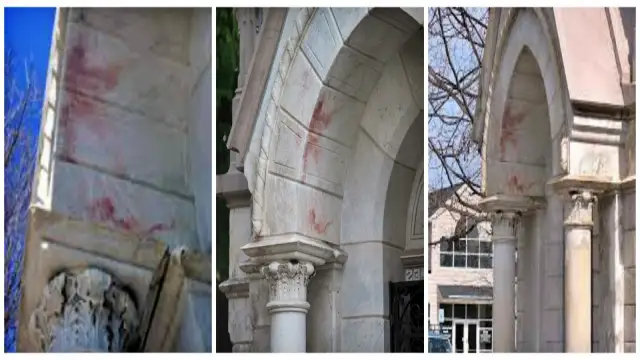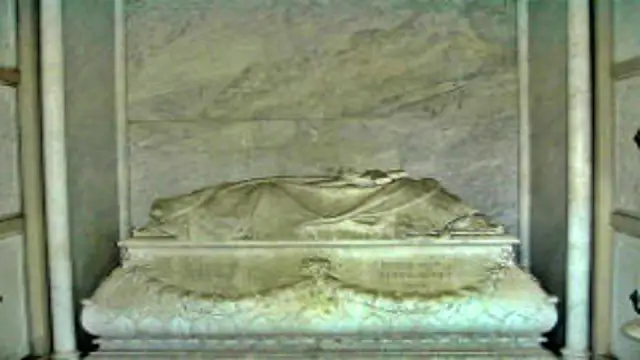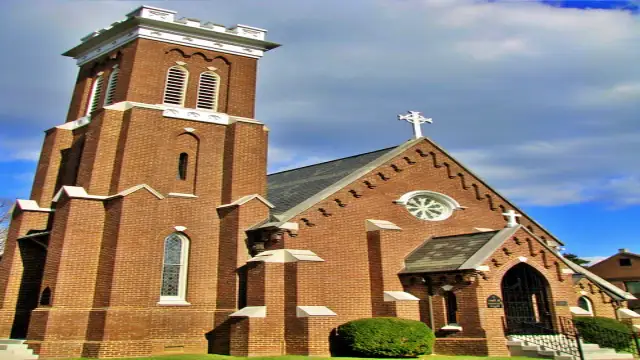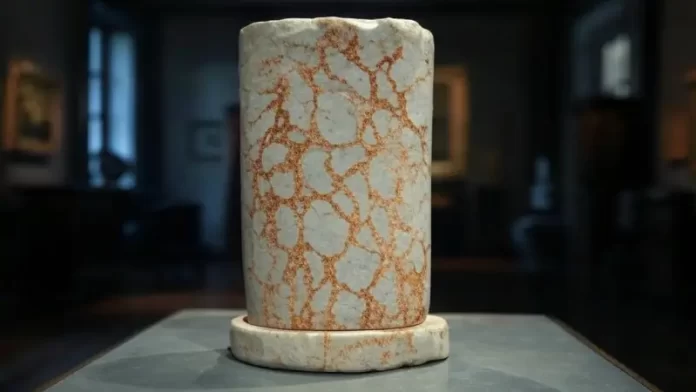Table of Contents
Tears of Marble? The Enduring Mystery of the Craigmiles Mausoleum
Head down to southeastern Tennessee, just a stones throw north of Chattanooga, and you’ll find the city of Cleveland. It’s a place with its share of history, like many Southern towns. But tucked away behind the venerable St. Luke’s Episcopal Church downtown sits something… different. Something that draws the curious and whispers tales of sorrow and the unexplained. It’s the Craigmiles Mausoleum, an imposing structure of white Italian marble, beautiful and stately. But it’s not just its architecture that captures attention. It’s the mysterious, deep red stains that seem to weep from its surface.

These aren’t subtle discolorations, mind you. They’re described as looking eerily like bloodstains, marring the pristine white stone. Locals will tell you, these stains been cleaned off countless times over the decades. Power washed, scrubbed, you name it. And yet? They always return. Sometimes fainter, sometimes reportedly darker, but always reappearing. This stubborn phenomenon has cemented the Craigmiles Mausoleum mystery as one of Cleveland’s most enduring legends, a magnet for history buffs, ghost hunters, and anyone intrigued by a good puzzle. So, whats the story behind this weeping tomb?
Fortune, Family, and a Foundation of Grief
To understand the mausoleum, you gotta understand the family who built it. John Henderson Craigmiles was a man who knew how to make money. A prominent local businessman, he made his fortune primarily in the shipping business. Cleverly (or perhaps pragmatically), he managed to sell food and supplies to both the Union and Confederate sides during the Civil War. Business was business, after all.
In 1860, right on the cusp of that national conflict, he married Adelia Thompson. She wasn’t just any bride; she was the daughter of a respected local physician, Dr. Thompson. Life seemed promising for the couple. In August of 1864, amidst the turmoil of war, their world brightened considerably with the birth of their first child, a daughter they named Nina.
Little Nina: A Cherished Life Cut Tragically Short
By all accounts, Nina Craigmiles was the apple of everyone’s eye. A beloved child, likely spoiled rotten in the way cherished children often are. She had a particularly special bond with her grandfather, Dr. Thompson. Folks around Cleveland often saw the two of them zipping around town in the doctor’s buggy as he made his house calls. The image is kinda charming, isn’t it? The respected doctor and his bright-eyed granddaughter, his little companion on his rounds.

There’s a detail in the local lore that adds a layer of poignant foreshadowing. Apparently, the doctor sometimes let young Nina, even at just seven years old, take the reins. The story goes that they both shared a bit of a thrill-seeking streak, liking to whip the horse to make the buggy go faster. A shared sense of adventure between grandfather and grandchild. Innocent fun. Until it wasn’t.
Tragedy struck with horrifying suddenness on a date steeped in cruel irony: October 18, 1871 St. Luke’s Day. Nina was out with her grandfather in the buggy, perhaps heading home from rounds, perhaps just enjoying a ride. As they approached a railroad crossing, disaster unfolded. Whether it was misjudgment, distraction, or the horse bolting, Dr. Thompson steered the buggy directly into the path of an oncoming train. The impact was catastrophic. Dr. Thompson was thrown clear, injured but alive. Little seven-year-old Nina was killed instantly. The light of the Craigmiles family had been extinguished in a horrific instant. The Nina Craigmiles story became one of sudden, devastating loss.
Memorials Etched in Stone and Marble
The grief that enveloped John and Adelia Craigmiles, and indeed the whole community, must have been immense. How do you even begin to process such a loss? For the Craigmiles, part of their healing, or perhaps their way of channeling their grief, involved creating lasting memorials to their cherished daughter.
Three years after Nina’s death, construction began on a magnificent new church building downtown: St. Luke’s Episcopal Church. It was explicitly commissioned in Nina’s honor. In a move heavy with symbolism, the stunning building was completed and consecrated on October 18, 1874 the third anniversary of her passing. A beautiful, enduring tribute built from sorrow.
Behind this new church, the family then erected the structure that would become central to the Cleveland TN mystery: the Craigmiles Mausoleum. No expense was spared. Fashioned from gleaming white Italian marble, it was designed to be impressive, a fortress protecting their daughter’s final resting place. The walls are reportedly four feet thick. A spire topped with a cross reaches 37 feet towards the heavens. Inside, Nina’s remains were placed in a marble sarcophagus at the center. Along the walls, six shelves awaited other family members when their time came. It was meant to be a place of peace, of beauty, of eternal rest.
The First Tears: The Mystery Begins
But peace wasn’t quite what settled over the mausoleum. According to the enduring local legend, it started soon after Nina was interred in her marble tomb. That’s when the red stains mausoleum phenomenon allegedly began. Streaks of crimson appeared on the pristine white exterior marble. Where did they come from? What could possibly cause such a thing on newly quarried and constructed stone?

Naturally, the stains were cleaned. But they came back. Cleaned again. They returned. This cycle, repeated over and over through the years, is the heart of the Craigmiles Mausoleum mystery. Vandalism seemed unlikely given the location and the nature of the stains they seemed to emanate from the stone itself. People started talking. Whispers turned into local lore. The most popular, and certainly the most poignant, explanation emerged: the stains were Nina, forever seven years old, “crying tears of blood” over the loss of her family members yet to come. The Nina Craigmiles legend took on a distinctly supernatural, sorrowful hue. Was the marble itself weeping in sympathy?
More Sorrow, Darker Stains? The Legend Grows
The story doesn’t end there, and neither did the Craigmiles family’s heartbreak.
- An Infant Son: Sometime after Nina’s death, John and Adelia suffered another blow the death of their infant son, just hours old. He was laid to rest in the family crypt alongside his sister. According to the legend keepers, the existing red stains on the mausoleum darkened noticeably after his interment.
- John Craigmiles (1899): The family patriarch, John, died unexpectedly in 1899. He reportedly slipped on an icy Cleveland street, and the resulting injury led to “blood poisoning” likely a severe infection like sepsis in today’s terms. He, too, was placed within the marble walls. And again, the legend insists, the stain on the arch above the door darkened once more.
- Adelia Craigmiles (1928): Decades later, tragedy struck the family matriarch. While crossing Cleveland Street, Adelia was hit by a car and killed. By now, the mysterious stains were a well-known local phenomenon. Locals claim that after Adelia joined her husband and children in the crypt, the stains reappeared yet again after being cleaned, perhaps darker and more persistent than ever before. Each family tragedy seemed to add another layer, another tear, to the weeping marble. It seemed the mausoleum itself shared the family’s grief. There were less doubters now than ever before.
Science Weighs In… And Shrugs?
Ok, so spooky legends are one thing. What about science? Surely there’s a rational explanation, right? Iron deposits in the marble oxidizing? Mineral seepage from the ground? Some kind of persistent algae or bacteria?
Well, maybe. Efforts have been made to get to the bottom of it. Vandalism has been consistently ruled out. But here’s where it gets really interesting: more recent chemical analyses have apparently been conducted. And the results? Inconclusive. According to reports discussing the mystery, the tests couldn’t definitively determine the composition of the stains or explain why they persistently reappear on that specific mausoleum marble. They essentially “defied the experts.” This scientific ambiguity, of course, only fuels the speculation and keeps the legend alive and well. It remains one of those peculiar haunted Tennessee locations where folklore and fact blur. The unexplained red stains remain just that unexplained.
Footnotes in History: A Lost Statue and a Famous Playwright
The Craigmiles story has a couple of other fascinating historical connections that add extra layers of intrigue:
- The Titanic Connection: The family, wanting another memorial to Nina, commissioned a beautiful bust sculpted from the same white Italian marble as the mausoleum. The plan was to place it in a special alcove, known as “Nina’s Niche,” inside St. Luke’s Church. The sculptor completed the work and shipped it from Europe. The vessel chosen for transport? The brand new, “unsinkable” luxury liner, RMS Titanic. The bust went down with the ship in April 1912, lost forever to the depths of the Atlantic. Today, Nina’s Niche in the church is traditionally filled with fresh flowers instead, a quiet memorial to both the girl and her lost likeness. The Titanic lost statue adds another touch of poignant loss to the family saga.
- The Tennessee Williams Connection: St. Luke’s Episcopal Church has another claim to fame. The grandfather of iconic American playwright Tennessee Williams served as rector there for sixteen years. Young Thomas Lanier Williams (Tennessee’s real name) spent many childhood summers in Cleveland visiting his grandparents at the rectory. One has to wonder, did the future playwright, known for his Southern Gothic dramas filled with tragedy and psychological depth, ever hear the whispers about the weeping mausoleum behind his grandfather’s church? Did the town’s atmosphere, perhaps tinged by this local mystery, seep into his young imagination? It’s tantalizing food for thought.
The Enduring Enigma of Cleveland, TN
So, the Craigmiles Mausoleum stands watch behind St. Luke’s, a beautiful monument born from tragedy. But it’s the inexplicable red stains that ensure its story continues to be told. Are they a natural phenomenon, some fluke of geology or biology that science hasn’t quite pinned down yet? Or is there something more to the Nina Craigmiles legend? Are they, as the folklore suggests, the tears of a heartbroken child eternally grieving her family within the cold marble walls?
Whatever the truth, the mystery endures. The stains serve as a constant, visual reminder of the Craigmiles family’s sorrow and the strange ways history and legend can intertwine. They keep the Cleveland TN mystery alive, drawing visitors and ensuring that little Nina, her family, and their story are never quite forgotten. Kinda makes you want to see it for yourself, doesn’t it?

